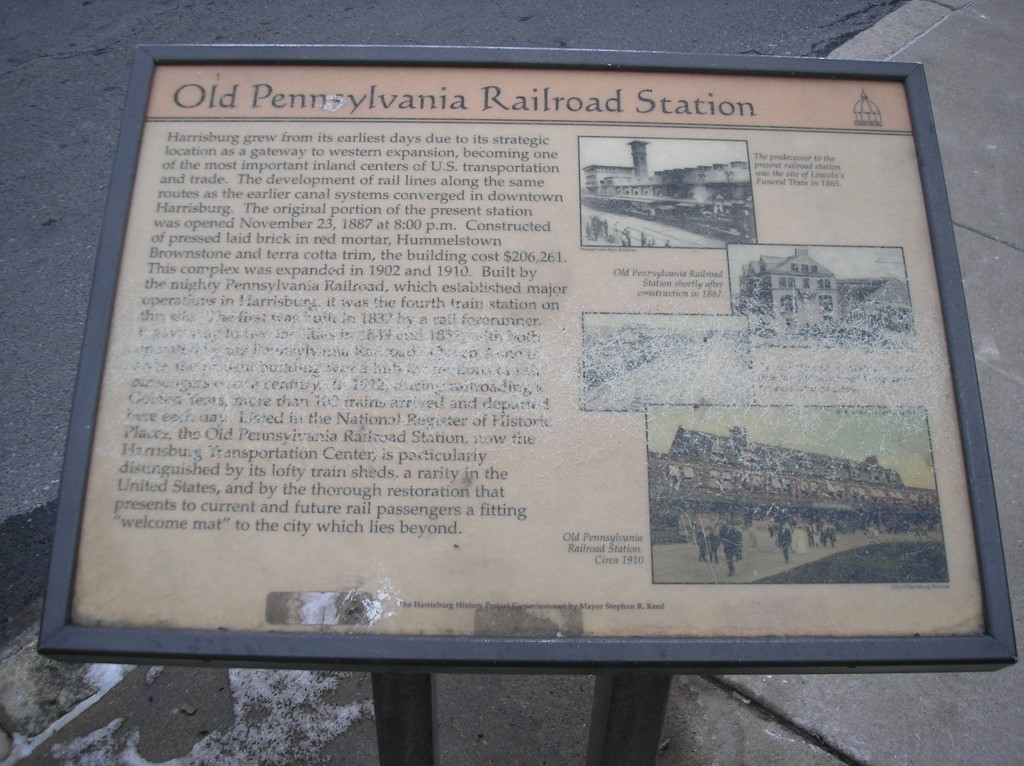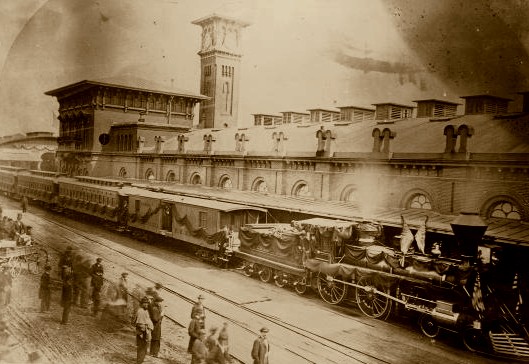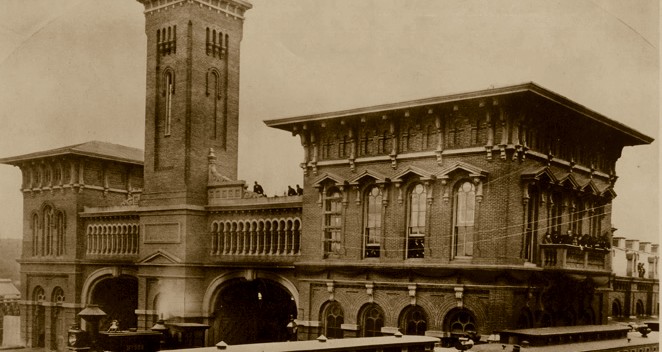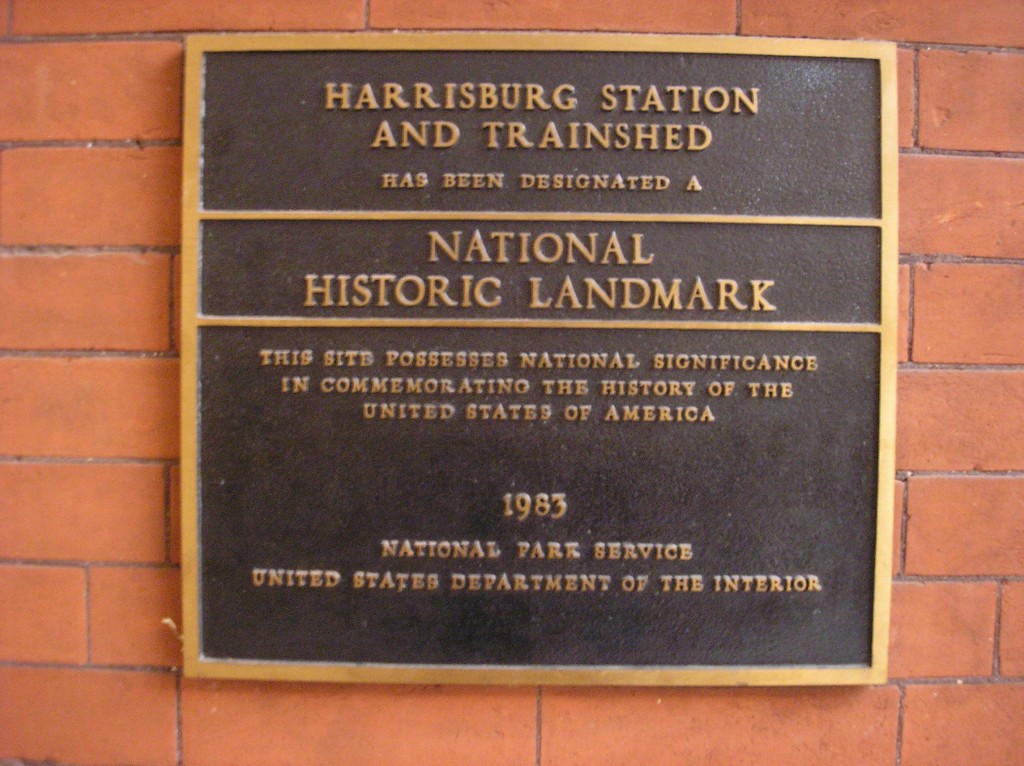Harrisburg – Old Pennsylvania Railroad Station
Posted By Norman Gasbarro on March 25, 2011
In the post yesterday, the historical marker, “Harrisburg – Crossroads of the Union,” which is in front of the historic Harrisburg Transportation Center, was discussed. Today, the other marker, “Old Pennsylvania Railroad Station,” will be presented. Since this marker traces the history of the railroad stations at this site, some background will be given on the evolution, decline, and resurgence of rail travel in the United States. This post will conclude tomorrow with some additional pictures of the renovated Harrisburg Pennsylvania Railroad Station.
It is unfortunate that this marker has either been vandalized or worn to the point where part of the inscription is almost unreadable. A picture of the marker appears on another site, with the statement that the posting was done on 27 March 2008. Some of the damage shows across the face of the marker, but additional damage is now shown in the picture shown above, which was taken in January 2011 – nearly three years later. Originally, the marker was placed by the Harrisburg History Project, Commissioned by Mayor Stephen R. Reed. No date is on the table, but Reed was Mayor of Harrisburg ten years ago when other historical projects were initiated, including the National Civil War Museum; Reed was one of the strongest campaigners to establish the museum in Harrisburg. The historical marker at the Transportation Center now needs repairs or replacement. Perhaps moving it away from a heavily used bus stop and taxi stand will help.
The following is an attempted reconstruction of the working on the marker.
Harrisburg grew from its earliest days due to its strategic location as a gateway to western expansion, becoming one of the most important inland centers of U.S. transportation and trade. The development of rail lines along the same routes as the earlier canal systems converged in downtown Harrisburg. The original portion of the present station was opened November 23, 1887 at 8:00 p.m. Constructed of pressed laid brick in red mortar, Hummelstown Brownstone and terra cotta trim, the building cost $206,261. This complex was expanded in 1902 and 1910. Built by the mighty Pennsylvania Railroad, which established major operations in Harrisburg, it was the fourth train station on this site. The first was built in 1837 by a rail forerunner. It gave way to two facilities in 1849 and 1857, with both operated by the Pennsylvania Railroad. Queen Anne in style, the present building was a hub for millions of rail passengers over a century. In 1922, during railroading’s Golden Years, more than 100 trains arrived and departed here each day. Listed in the National Register of Historic Places, the Old Pennsylvania Railroad Station, now the Harrisburg Transportation Center, is particularly distinguished by its lofty train sheds, a rarity in the United States, and by the thorough restoration that presents to current and future rail passengers a fitting “welcome mat” to the city which lies beyond.
The top photograph is of the Civil War era station on this site:
Another picture of the same station from a different view:
In the above picture, Lincoln’s funeral train (at bottom of picture) has been cropped out. Those who wish to see the full version of the picture can click here. The picture on the Pennsylvania Abraham Lincoln Bicentennial Commission site was taken from an original picture from the collection of the Pullman Museum. The copy of the original of the photo above is not on the historical marker. For pictures two and three on the marker, it is impossible to read the captions or see the photo because of the damage to the marker.
The final picture on the marker is of the Harrisburg Pennsylvania Railroad Station as it appeared in 1910. As stated on the historical marker, this station replaced the Civil War era station in 1887 with additions completed to the basic 1887 structure in 1902 and 1910.
 Although the 1910 station bears little resemblance to the Civil War era station, it is on the same site and essentially serves the same purpose making Harrisburg a “crossroads” for rail traffic going east and west as well as north and south. This station underwent significant renovation and restoration in the early 1980s, and in 1983, became a National Historic Landmark under the National Park Service, United States Department of the Interior.
Although the 1910 station bears little resemblance to the Civil War era station, it is on the same site and essentially serves the same purpose making Harrisburg a “crossroads” for rail traffic going east and west as well as north and south. This station underwent significant renovation and restoration in the early 1980s, and in 1983, became a National Historic Landmark under the National Park Service, United States Department of the Interior.
Another plaque inside the station recognizes the Civil War era station, traces the history of the railroad, and indicates that the train shed was a pre-Civil War patented design.
The Pennsylvania Railroad was chartered in 1846 by the Commonwealth which authorized the company to build a line between Harrisburg and Pittsburgh to parallel the state-owned canal and inclined plane system. When the line opened in 1855, the last rail link between Pittsburgh and Philadelphia was complete. Expanding 10,000 miles to serve the northeast and midwest the Railroad operated under its original charter until 1962 when it merged with the New York Central to form the Penn Central. In 1971 Amtrak was created after the Penn-Central filed for bankruptcy.
The Harrisburg station, located on the main line of the Pennsylvania Railroad and completed in 1887, was the first built by the company in the City. It is composed of two distinct parts, the passenger building and sheds. The passenger building, which has been extensively remodeled in various campaigns, remains a good example of turn of the century railroad construction. It was built under the direction of William Henry Brown, the Pennsylvania Railroad’s Chief Engineer, whose duties involved all aspects of civil engineering undertaken by the Railroad.
The Station has particular engineering significance because of its two train sheds, which are preserved unaltered and largely intact. They represent a recent ancestor to skyscraper engineering. The roof truss prototype was patented by Albert Fink in 1854. Its use here is a unique “hybrid” form combining iron and wood components in the same structure.
The final restored building and train shed is now known as the Harrisburg Transportation Center, a multi-modal service facilities for train, long distance bus service, local bus service, and taxi.
While the Civil War station no longer exists, undoubtedly G.A.R. veterans from the Lykens Valley area who were on the way to state and national encampments traveled to it or through it. The modern architectural changes they saw as well as the great era of the steam locomotives in the latter part of the nineteenth century were results of the Civil War and its aftermath.
Tomorrow: Pictures of the renovated Harrisburg Pennsylvania Railroad Station as the new Harrisburg Transportation Center.
The black and white photograph of the Harrisburg Pennsylvania Railroad Station is from Wikipedia and is in the public domain. The picture post card view of the same station would not have been possible to reproduce here because of the damage to the plaque.
 ;
;







Comments